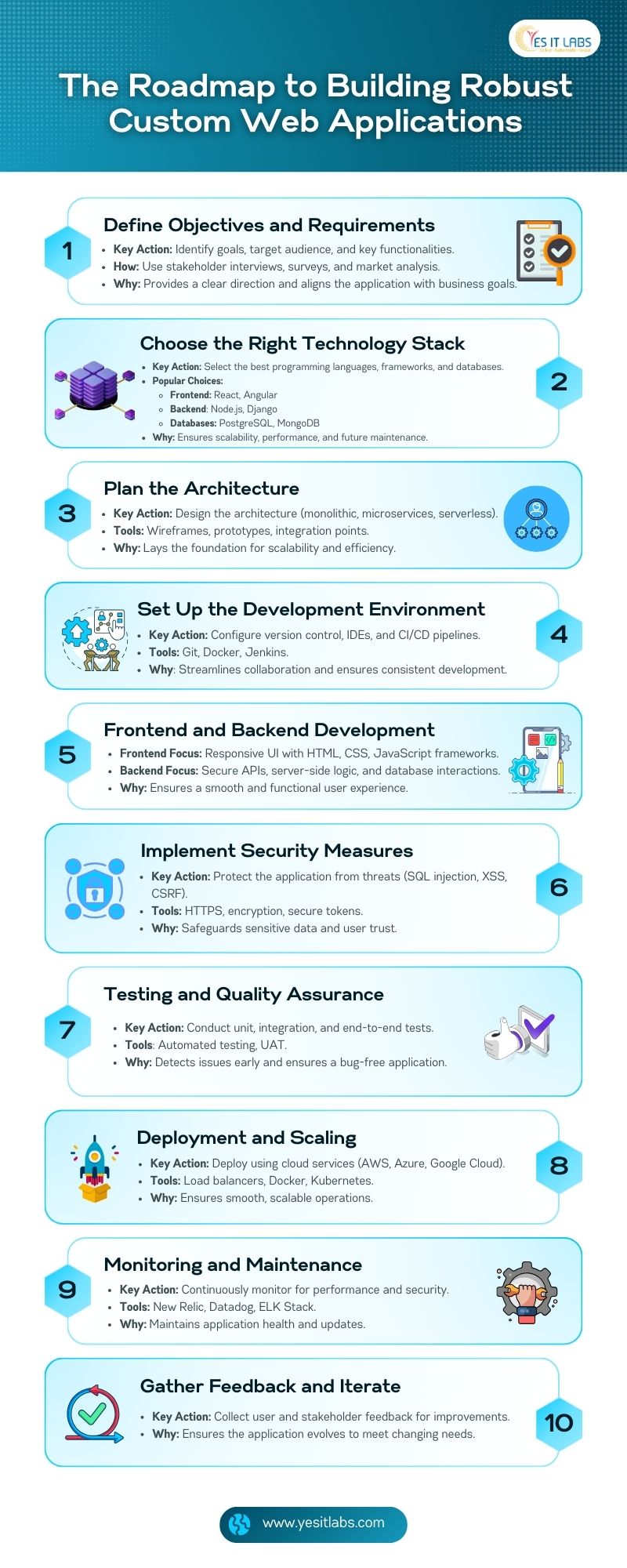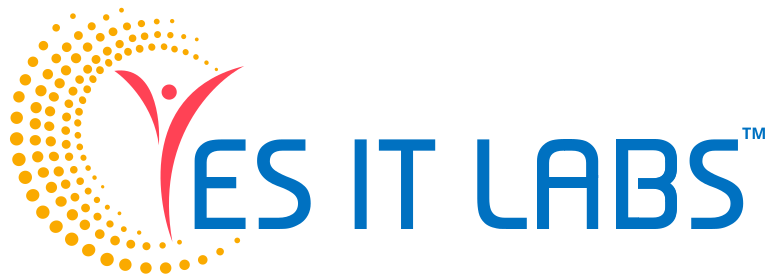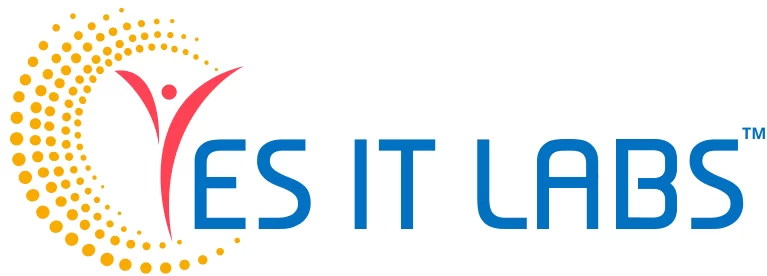In the era of digital transformation, custom web applications have become essential for businesses seeking to gain a competitive edge. Leveraging custom web application development services is no longer a luxury but a necessity for organizations aiming to create tailored solutions that address specific business needs. However, building a robust custom web application is no small feat. It requires deep technical expertise, a clear roadmap, and an agile mindset. This guide provides you with a comprehensive, engaging, and unique roadmap to building a high-performing custom web application.
-
Define Your Objectives and Requirements
Before any code is written, it’s crucial to clearly define the goals and requirements of your web application. You need to outline the core objectives, identify the target audience, and determine the primary functionalities. This phase typically involves gathering insights from stakeholder interviews, conducting competitive analysis, and even user journey mapping to ensure the application meets both business goals and user expectations. Partnering with a software development service provider can help streamline this phase, bringing in the right expertise to align technical feasibility with strategic goals.
-
Choose the Right Technology Stack
Choosing the right technology stack is critical for your project’s long-term success. This decision should be based not only on the application’s current requirements but also on scalability, maintainability, and developer expertise within your team. Popular front-end frameworks include React for its flexibility and performance, or Angular for more complex, large-scale applications. For back-end solutions, consider Node.js for its event-driven architecture, or Django for projects that require fast development with secure defaults. On the database side, PostgreSQL is a go-to for relational data, while MongoDB is better suited for document-oriented needs. Also, factor in performance optimizations such as choosing Redis for caching or GraphQL for efficient data querying. Don’t forget to choose a CSS preprocessor like Sass for maintainable stylesheets in complex UIs.
-
Plan the Architecture
A well-thought-out architecture ensures your application is scalable and maintainable. Depending on the application’s complexity and traffic requirements, you may opt for a monolithic architecture for simplicity or microservices for more scalability and flexibility. In recent years, serverless architecture using AWS Lambda or Azure Functions has gained traction, particularly for projects that experience fluctuating loads or for MVPs that need to be developed quickly. Consider setting up load balancing and CDNs (Content Delivery Networks) to optimize content delivery and improve user experience. This is also the stage to choose between NoSQL vs. SQL databases based on the nature of your data models.
-
Development Environment Setup
Setting up a productive development environment is often overlooked, but it’s crucial for the development team’s efficiency. Ensure proper version control using Git with branching strategies (like GitFlow) to facilitate smooth collaboration. Set up IDEs like Visual Studio Code or JetBrains IDEs with necessary plugins, linters, and code formatters for best practices. Automate testing, linting, and code analysis using tools like Jenkins or GitHub Actions for CI/CD pipelines. Docker can be used to standardize development environments, minimizing the “it works on my machine” problem.
-
Frontend and Backend Development
Development is typically split between front-end and back-end. For front-end development, consider using component-based frameworks like React or Vue.js for better scalability and reusability of UI elements. Ensure that your web app is responsive by adopting mobile-first design principles, and optimize performance by lazy-loading assets and minimizing DOM manipulations. Backend development focuses on creating a secure and scalable API, using best practices such as RESTful architecture or GraphQL depending on the complexity of the data interactions. Ensure proper ORM (Object-Relational Mapping) tools like Sequelize or SQLAlchemy are used to simplify database interactions. Secure authentication and authorization systems should be implemented using OAuth 2.0 or JWT (JSON Web Tokens).
-
 Implement Security Measures
Implement Security Measures
Security should be baked into every layer of your web application. Besides the obvious safeguards like protecting against SQL injection, XSS, and CSRF attacks, ensure that all external communications use HTTPS with SSL certificates. Follow the OWASP Top Ten recommendations, and use Content Security Policy (CSP) headers to prevent XSS attacks. Regularly update dependencies to avoid vulnerabilities introduced by third-party libraries. Implement role-based access control (RBAC) to protect sensitive data and use multi-factor authentication (MFA) where applicable. Ensure that passwords and sensitive data are encrypted using hashing algorithms like bcrypt.
-
Testing and Quality Assurance
Testing is an essential part of the development process. Apart from unit tests, consider integration tests to ensure that all modules of the application work together as expected. End-to-end (E2E) tests using tools like Cypress or Selenium can simulate user interactions to verify the app behaves as expected in real-world scenarios. Performance testing using tools like Lighthouse or JMeter should be performed to identify bottlenecks. It’s also critical to conduct accessibility testing to ensure your app complies with WCAG standards, providing a seamless experience for all users.
-
Deployment and Scaling
When it comes to deployment, reliability and scalability are key. Automate deployment pipelines using CI/CD tools like GitLab or CircleCI. Choose reliable cloud hosting platforms like AWS, Azure, or Google Cloud, ensuring services like Elastic Load Balancing (ELB) and Auto Scaling Groups are configured for scaling. Use Docker containers for easy horizontal scaling and manage them with Kubernetes or Docker Swarm. Additionally, implement blue-green deployment strategies to minimize downtime during new releases, and always have rollback mechanisms ready.
-
Monitoring and Maintenance
Post-deployment, ongoing monitoring and maintenance are essential to ensure your application continues to perform optimally. Tools like New Relic, Datadog, or Prometheus can monitor real-time application performance and send alerts in case of anomalies. Log management systems like ELK Stack (Elasticsearch, Logstash, and Kibana) or Graylog should be implemented for comprehensive log analysis. Don’t forget to regularly apply security patches and conduct penetration tests to ensure ongoing security. Automated backups and disaster recovery plans should be in place to mitigate potential data loss.
-
Gather Feedback and Iterate
After deployment, gathering continuous feedback from users and stakeholders is crucial for iterating and improving the application. Tools like Hotjar or Google Analytics can track user behavior and identify pain points in user experience. Regularly release feature updates based on this feedback while prioritizing bug fixes and security patches. Conduct code reviews to ensure that the codebase stays maintainable and avoid technical debt.
Conclusion
Building a robust custom web application requires a careful balance of technical expertise, planning, and iteration. By leveraging custom web application development services and following this roadmap, you can create a web application that not only meets your business objectives but also delivers exceptional performance and user experience. Stay agile, embrace new technologies, and continuously refine your approach to remain competitive in a fast-evolving digital landscape.
Listen this Blog Podcast on Spotify
FAQs
1. What are custom web application development services, and why are they important?
Custom web application development services involve creating tailored web applications specifically designed to meet the unique needs of a business. Unlike off-the-shelf solutions, these custom applications offer flexibility, scalability, and functionality that align perfectly with a company’s specific processes and goals. They are important because they help businesses improve operational efficiency, enhance user experiences, and gain a competitive advantage by offering features and services that fit their exact requirements.
2. How do I choose the right technology stack for my custom web application?
Choosing the right technology stack depends on the project’s specific requirements, including scalability, security, performance, and maintenance needs. You should consider front-end frameworks like React or Angular for the user interface, back-end technologies like Node.js or Django for server-side operations, and databases like PostgreSQL or MongoDB for data storage. In addition, it’s important to think about the future growth of your application, the availability of developers familiar with the chosen stack, and how well the technologies integrate with each other.
3. What are the main security measures to implement in a custom web application?
Implementing robust security measures is essential for protecting a custom web application from cyber threats. Key practices include using HTTPS for secure communication, safeguarding against SQL injection, Cross-Site Scripting (XSS), and Cross-Site Request Forgery (CSRF) attacks, and enforcing strong authentication and authorization protocols like OAuth 2.0 or JWT. Additionally, encrypt sensitive data, regularly update third-party libraries to patch vulnerabilities, and conduct security audits and penetration tests to identify and fix security gaps.
4. What is the role of testing and quality assurance in custom web application development?
Testing and quality assurance (QA) play a crucial role in ensuring that a custom web application is stable, secure, and user-friendly. It involves various types of tests, including unit tests to check individual components, integration tests to ensure different modules work together, and end-to-end tests to simulate real user interactions. Automated testing tools can help catch bugs early in the development process, while User Acceptance Testing (UAT) ensures the application meets business and user requirements before going live. QA helps maintain a high standard of performance and minimizes post-launch issues.
5. How do I ensure my custom web application is scalable after deployment?
To ensure your custom web application can scale effectively after deployment, use cloud hosting platforms like AWS, Azure, or Google Cloud that offer auto-scaling services. These platforms allow your application to handle increased traffic by automatically adjusting resources like CPU, memory, and storage. Implement load balancers to distribute traffic efficiently, and use containerization tools like Docker with orchestration solutions like Kubernetes to streamline scaling. Additionally, optimizing code for performance and conducting regular load testing will help ensure your application scales seamlessly as demand grows.








